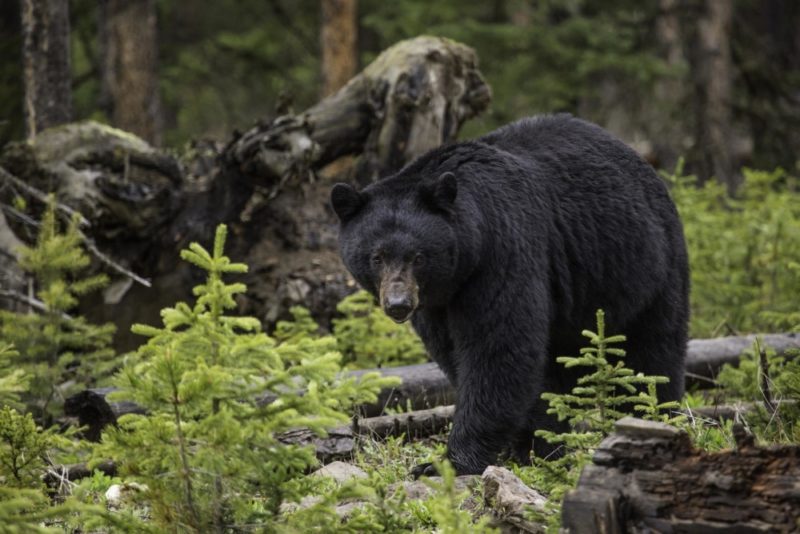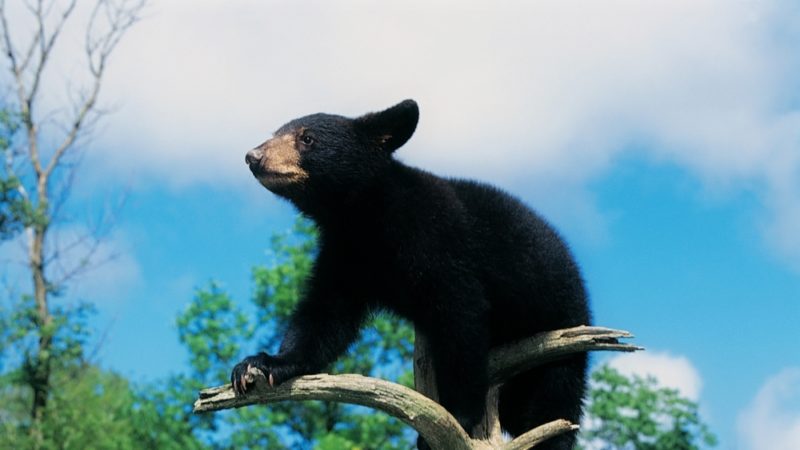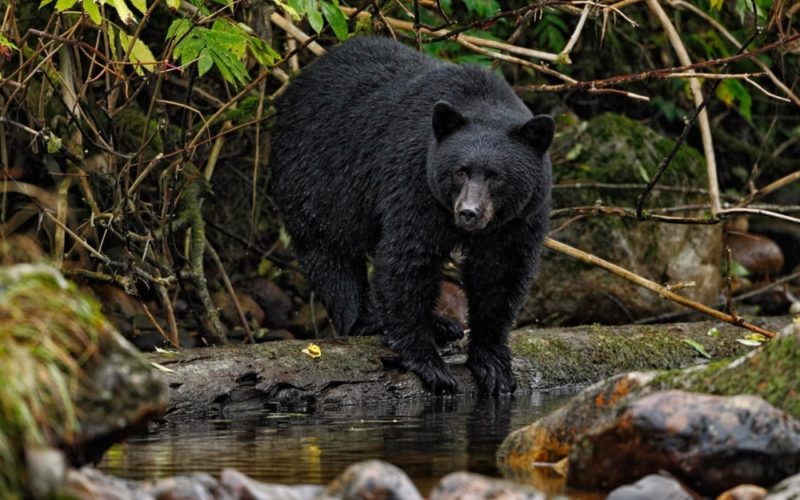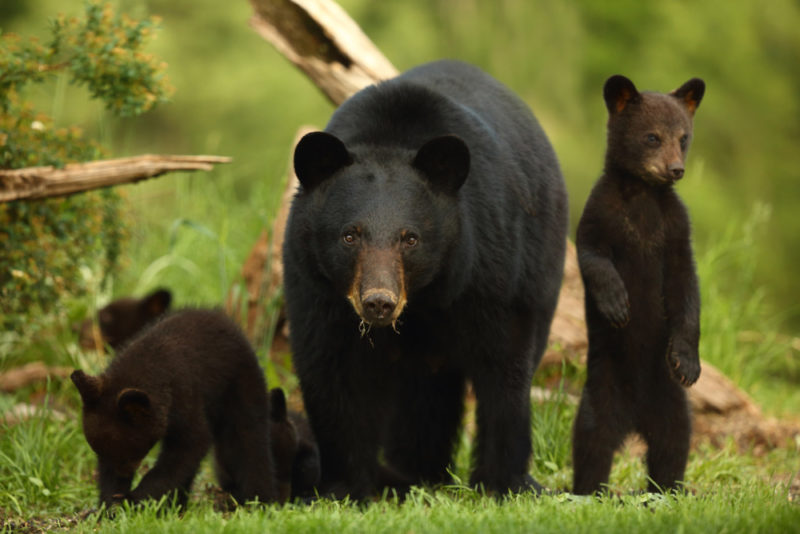The prototype of the famous childhood heroes - Teddy bears, Winnie the Pooh and the Smokey bear - lives in North America. This black bear is a very intelligent and fearful creature. He is interesting for his behavior, amazing color and complaisant character.
Material Content:
Description of the appearance of a black bear
Baribal (Ursus americanus) is a relatively small bear. One and a half meter body length from muzzle to tail. On average, it weighs 135 kg, although there are individuals that are large enough for this type of size in two and a half centners. Of course, such large animals turn out to be males only and occur in the fall when the bears have already fattened. Females are one third less than males.
A feature of this species is its high paws. The nails are long, sharp. The pointed shape and reddish color of the tip of the muzzle of the baribal are noteworthy, whatever the overall color of his fur coat.
This bear has a short coat, well-fitting to the body, smooth, most often black. Sometimes individuals with a brownish tint are found. Bears in one bear can be born with a different shade of fur. Often the chest of a black bear is marked with a white spot.
Light brown baribals are found on the west coast of the United States. Glacier bears - this species lives in Alaska - have a wonderful silver coat with a blue tint. White baribals live on Gribbel Island.
Baribal habitat
The distribution range of baribal is quite extensive. It occupies large areas, starting from the north of Canada, passes through the United States of America and up to the central regions of Mexico. In width - from the ocean to the ocean of the North American continent.
Baribal usually lives in a wooded area, away from human habitation. It can be found in the mountains and on the plain. However, the animal tries to avoid agricultural areas.
These bears settle closer to the edge of the forest, where trees meet with meadows. Wetlands and humid lowlands are also good for them. Baribals prefer to stay in those areas where there is access to drinking water - small rivers, streams. Bears not only drink water, they cool in the ducts during the summer heat.
Baribals love to feed in the forest glades penetrated by the sun, where there are a lot of juicy greens of berries. The most suitable for a small bear will be the place where all kinds of fruit and nut plants grow.
For growing offspring, it is necessary that the surrounding trees are quite large - trunks of at least 50 cm in diameter. In addition, the bark must be replete with cracks and folds so that the cubs can learn to climb. Since babies have natural enemies in nature, the bears prefer to spend the night for their babies on such trees.
Lifestyle, Nutrition and Behavior
Baribals are not aggressive, quite compliant in nature and very quick-witted. Therefore, their behavior is very interesting to watch. According to employees of the state reserve of the state of Georgia (USA), these bears, raiding farm fields, are smart. As soon as farm workers appear, they immediately run away into the forest. They wait patiently while the reserve staff investigates the problem with the farmers. Watch what is happening, hiding behind the trees. As soon as people leave the field, they immediately return back.
The black bear behaves timidly, carefully, it can be easily scared. There have been times when even domestic cats emerged victorious from a clash with baribal. Therefore, the bear tries not to meet people, other large representatives of the animal world.
The lifestyle of this animal is the search for food, couples for mating, as well as relaxation. Baribal spends a lot of time traveling through the forests. It can cover a considerable distance in a day. The male can walk up to 12 km. The female is slightly smaller - 9 km.
The bear is active early in the morning, in the evening, sometimes at night. It rests more in the daytime, especially in the hot season.
Baribal is omnivorous; he is especially indiscriminate in food. Eats all kinds of insects, larvae. Its main diet, up to 95%, is a vegetable diet - herbs, fruits, nuts, berries, mushrooms, acorns. Meat gets to him more often as carrion. Although a black bear is able to catch and eat any small animal - from a mouse to a small deer.
During salmon spawning in the rivers, baribals go ashore to enjoy oily fish and delicious caviar. The most important time for the bear is autumn. He must accumulate subcutaneous reserves to safely hibernate and survive the winter. This is especially important for females waiting for offspring.
Despite the fact that the black bear baribal is a predator, it nevertheless feeds fat on plant foods. These are nuts, acorns and fruits, which he absorbs in large quantities every day - how much will fit in his stomach.
Breeding and offspring
From May to July, after the bears leave their hibernation, the mating period begins. The pregnancy following this lasts a little over seven months.
Pregnant bears have a strange feature. The fact is that the fetus begins to actively develop only when the animal accumulates the required amount of fat. This happens only in the last autumn days.
Babies are born in the winter cold, in the den, when the bear is in hibernation. The weight of the newborn teddy bear is about 450 g. Immediately after birth, a tiny creature, clinging to the mother’s hair, crawls up her stomach, looking for a nipple. All winter, the baby eats fat milk and grows pretty quickly.In the spring, the teddy bear already weighs almost 5 kg. It turns out that body weight increases by almost 10 times.
If the bear was born only one baby, then she can leave him to their own devices. This is probably what nature ordered: the only teddy bear will grow up uncompetitive. The female will actively take care only of a brood of 2-4 babies.
With the onset of heat, the female, together with the cubs, gets out of the den. Toddlers relentlessly follow their mother. She teaches them to find tasty roots, berries, to hunt, accustoming the brood to meat. Then the cubs receive hunting lessons, first for small animals, and then larger game.
A year later, the grown young bears leave their mother. Then comes the period of a new pairing for her.
Life span
Usually baribals live about 25 years. However, in the wild, rarely does any of these animals boast such a long life span. Mostly they die at the age of about 10 years. The reason most often are various diseases, accidents, as well as their natural enemies.
However, the greatest damage to the number of baribals in the forests of North America is still caused by humans. Since it takes away its habitat from animals, it is building houses and housing where bears live.
Unfortunately, animals are attracted to human habitation by household garbage. It often happens that bears go out to their houses, rummage in garbage bins, and eat plastic waste together with leftovers, which leads to their death.
The reason for such a short life in the natural environment is also a car accident, when animals go to the tracks, especially in the dark. In many ways, poachers also contribute to this.
In the 19th century, there were about 2 million baribals, and today there are only 200 thousand left. This is enough for the species to reproduce well, but the threat of complete extinction is obvious.
Interesting Facts
There are interesting facts that make baribals special:
- The sight of these bears is colored, they see well, therefore they distinguish food very well and hunt well.
- The smell of baribal is a hundred times better than that of humans. He can smell prey or the enemy easily from a long distance.
- Black bears are great runners. They can move very quickly, at speeds up to 55 km / h. At the same time, they run great both on the plain and uphill, practically without slowing down. Therefore, it is simply impossible for a person to escape from this bear.
- Baribals nimbly climb trees. Even an old bear is able to climb a tree very quickly and feels there as well as on the ground.
- These bears move long distances. An animal can walk up to 200 km per day.
- The only drawback is that black bears do not swim very well. Although any of them is able to swim in fresh water for more than 2.5 km. There is a legend that one of the baribals crossed the bay, whose width is more than 14 km.
- When a bear hibernates, its body temperature drops by almost 9 degrees, and its heart rate drops from 70 beats to 10.
- Baribals have a fairly large brain, when compared with the general size of the body. Perhaps that is why they have a wonderful long-term memory. They perfectly understand - they can draw conclusions in terms of simple concepts. This species is considered extremely intellectually developed.
Judging by all these data, black bears in nature can be very dangerous for humans. Despite its seemingly small size, over the past 100 years, 36 people have died due to the fault of baribals. This is not such a big figure when compared with other species of bears. And yet, when meeting with a baribal, you should be careful.
These animals, thanks to their intelligence, lend themselves well to training and often become successful movie actors.

















